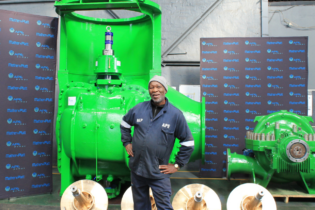Dr Sharon Pollard, a researcher from the Association for Water and Rural Development (AWARD) was honoured by the Water research Commission (WRC) during the Technology Symposium Gala Dinner held on 26 September at the CSIR Convention Centre for her contribution to research making up the Shared Rivers Initiative focusing on collective action for improved water resource management.
The research team was honoured with the ‘WRC Knowledge Tree Award’ specifically which was awarded to projects that have provided appropriate evidence-based information to guide decision-making. The Shared Rivers Initiative (SRI), an action-research programme funded through the Water Research Commission, was initiated in 2007. One component of the Shared Rivers Initiative explored the progress towards meeting the commitment to sustainability of South Africa’s lowveld rivers as set out in the National Water Act (RSA, 1998). The study aimed to answer the central question: ‘What factors enable or constrain achieving environmental flows in the lowveld rivers? ‘. The aim was to provide a preliminary assessment of the status of sustainability of the water resources of the six lowveld river systems, and the factors that constrain or contribute to this, in order to provide a grounding from which the project was able to design and implement real change. “By understanding the underlying factors that constrain or enable meeting the commitment to the Reserve, a meaningful and tenable supportive programme can be designed (both research and practice focused) for real change’’, says WRC Research Manager, Mr Bonani Madikizela . The study area comprised six major rivers of the South African lowveld: the Luvuvhu, Letaba, Olifants, Sabie-Sand, Crocodile and Komati Rivers. In South Africa these rivers and their catchments comprise three Water Management Areas (WMA): the Luvuvhu/ Letaba WMA in the north, the Olifants WMAs in the central region, and the Inkomati WMA, which comprises the Sabie-Sand, Crocodile and Komati Rivers in the south. All six rivers contribute to international watercourses, the Limpopo and Incomati basins. None of the eight rivers examined met the Reserve requirements for flow i.e. non-compliance was evident throughout. With the exception of the Sabie River, this situation has deteriorated since the National Water Act (NWA) was promulgated in 1998. Whilst this might present a dismal picture of progressive implementation, it is believed that this will improve in the Inkomati WMA in the near future, certainly in the case of the Crocodile River. Recent developments for a catchment-based water resources management system will firstly incorporate the Ecological Reserve (ER) as well as international obligations and secondly re-align and incorporate sector-specific management targets. It is hoped that this will be accompanied with improved regulation and enforcement.“Government needs to lead the way through a cohesive strategic plan that includes frameworks, tools and management systems to operationalise the Reserve. This means embedding the process in catchment-scale plans for IWRM (such as the Catchment Management Strategies)”, said Dr Pollard. The Sand River Catchment for example, illustrates the outcomes of a failure to adopt a systems view as the basis of governance and management. Despite policy commitments to change these intentions have failed to materialise in practice. Interpretations of the problem in isolation have led to poor mitigatory investments. This reflects on the leadership challenge and governance. Mr Madikizela further explained that the Reserve cannot be achieved without a compliant or lawful catchment-based system such that water use is authorized, regulated and monitored against the Reserve requirements. This requires adequate skills and resources for compliance monitoring and enforcement and involvement of stakeholders in monitoring, reporting and rectification of transgressions. Self-regulation needs to be explored. According to Dr Pollard and her collaborator Mr Derick du Toit a number of cases of unlawful use were raised in each catchment. All of the sub-catchments are bedevilled by major issues with regard to municipal expansion and effluent control. The expansion of mining in the Komati, Crocodile and the Olifants is problematic. Overall, monitoring and regulation is inadequate and lacks coherency. Very concerning is the dearth of legal and regulatory skills and support. The view that the “regulator cannot regulate” was pervasive – even by the regulator themselves. The fragmented or inadequate legal back-up to regions by the national legal division is a growing problem. In all the catchments with weak feedbacks, regulation competency requires urgent attention. The SRI has been complemented by a second phase SRI-II II which comprised a team of three key researchers (Pollard, Du Toit and Ramin Pejan) aimed to address some of the key issues that emerged from SRI-II. This included support for the development of legal competence, the development of a participatory process for understanding ecosystem services as envisaged in classification and on-going support for collective action in Intergrated Water Resources Management (IWRM).








